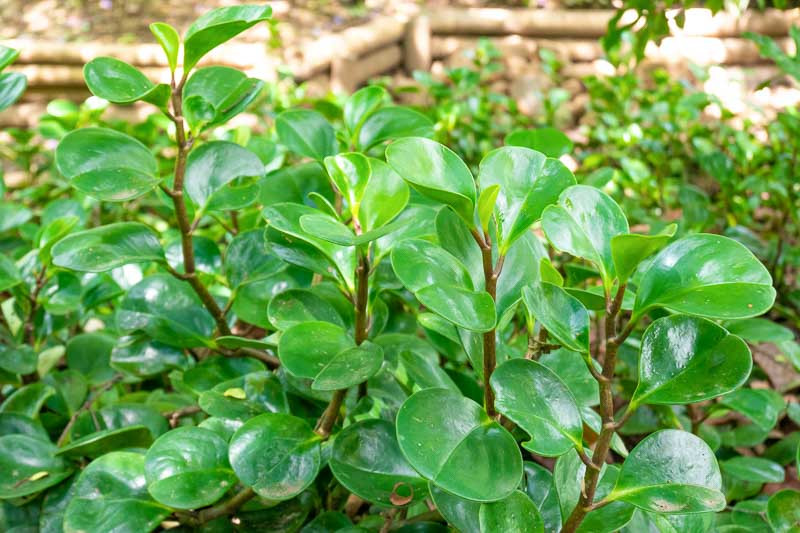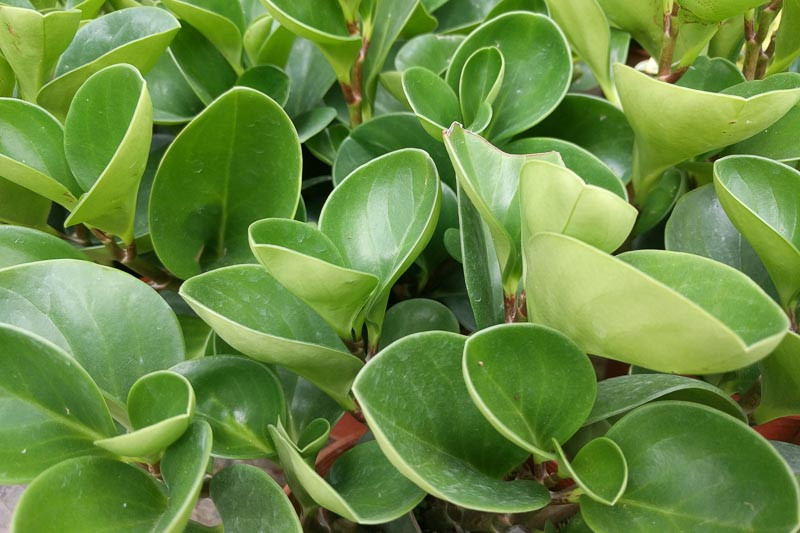Baby Rubberplant, Baby Rubber Plant, American Rubber Plant, Pepper Face, Peperomia floridana, Piper obtusifolium, Rhynchophorum floridanum, Rhynchophorum obtusifolium
Peperomia obtusifolia, commonly known as the baby rubber plant or pepper face plant, is a popular houseplant cherished for its ease of care, attractive glossy leaves, and compact growth habit. Its resilience to neglect and low maintenance requirements make it suitable for beginners.
Peperomia obtusifolia features thick, upright stems with round, glossy, dark green leaves. Its succulent-like qualities make it a resilient and forgiving plant, ideal for indoor gardening enthusiasts of all levels.
Native: Peperomia obtusifolia is native to Florida, Mexico, and the Caribbean, where it thrives in warm, humid environments, often under the canopy of larger trees. It belongs to the pepper family (Piperaceae) and is part of a diverse genus with over 1000 species.
Plant Type and Habit: This is an erect and bushy evergreen perennial with a compact growth habit.
Size: It typically grows to about 6 to 12 inches (15 to 30 cm) in height and spread.
Flowers: Blooming periodically throughout the year, it produces tiny creamy-white flowers in slender spikes that can extend above the foliage. The flowers are not particularly showy and are often overlooked in favor of the plant’s lush foliage. Indoor plants may not always flower.
Foliage: The foliage is the main attraction, with its thick, glossy, broadly elliptic leaves, about 2-4 inches long (5-10 cm). The leaves can be solid green or variegated, depending on the cultivar.
Hardiness: It is suited for USDA hardiness zones 10 to 12 if grown outdoors. Indoors, it prefers temperatures between 65°F and 75°F (18°C to 24°C) and moderate to high humidity levels.
Award: Recipient of the prestigious Award of Garden Merit of the Royal Horticultural Society.
Uses: Low-growing, the baby rubber plant quickly forms a spreading clump, making it ideal as a groundcover in tropical locations. Its compact size and attractive foliage make it a popular choice for office desks, shelves, and indoor plant arrangements.
Toxicity: Peperomia obtusifolia is non-toxic to cats, dogs, and humans, making it a safe addition to households with pets and children.
Benefits: Like many houseplants, Peperomia obtusifolia is believed to help purify the air by removing pollutants.

Growing and caring for Peperomia obtusifolia or baby rubber plant, is relatively easy, making it an excellent choice for both novice and experienced plant enthusiasts.
Light: Peperomia obtusifolia does well in moderate to bright, indirect sunlight. Avoid direct sun exposure, which can scorch the leaves. A spot near a window with a sheer curtain would be ideal to filter the light. A spot under a tree or on a shaded patio is ideal if grown outdoors.
Soil: Use a well-draining potting mix. A mixture of peat, perlite, and coarse sand is ideal for ensuring good drainage and aeration. If planting in the ground, ensure the soil is well-aerated and amend it with compost or peat moss to improve drainage and fertility.
Water: Water the plant when the top inch of soil feels dry to the touch. Overwatering can lead to root rot, so ensure the pot has good drainage. Water thoroughly, allowing excess water to drain out. Reduce watering in the winter months when plant growth slows down.
Temperature and Humidity: Keep the plant in temperatures between 65°F and 75°F (18°C to 24°C). Protect it from drafts and sudden temperature changes. This plant appreciates moderate to high humidity but is quite adaptable and can tolerate lower humidity levels found in most homes. Mist the leaves regularly, use a pebble tray, or place a humidifier nearby to increase humidity.
Fertilization: Feed with a diluted, balanced, liquid fertilizer once a month during the growing season (spring and summer). Avoid fertilizing in the fall and winter.
Pruning: Prune lightly to remove any yellow or damaged leaves and to encourage bushier growth. Use clean, sharp scissors or pruners to avoid damaging the plant.
Repotting: Repot every 2-3 years or when the plant becomes root-bound. Choose a pot only one size larger than the current one to avoid overwatering.
Propagating Peperomia obtusifolia, commonly known as the baby rubber plant, is a straightforward process that can be achieved through leaf cuttings, stem cuttings, or division. Here’s how to do it:
Propagation is most successful in the warmer months of spring and summer when the plant is actively growing. With patience and proper care, you’ll soon have new Peperomia obtusifolia plants to enjoy or share with friends.

Peperomia obtusifolia, commonly known as the baby rubber plant, is generally resilient and low-maintenance but, like all plants, it can encounter its share of pests, diseases, and common problems.
Spider Mites: These tiny pests can be identified by the fine webs they weave on the plant. They cause yellowing or speckled leaves. Increase humidity around the plant and wash it with a strong stream of water. For severe infestations, use insecticidal soap or neem oil.
Mealybugs: These white, cottony pests tend to cluster in leaf axils and under leaves, sucking sap and weakening the plant. Remove with alcohol-dipped cotton swabs or apply neem oil.
Fungus gnat: Overwatering can lead to these pests. Let the soil dry out more between waterings, and use yellow sticky traps to catch adult gnats.
Scale insects: Hard or soft-bodied insects that attach themselves to the stems or leaves, causing yellowing and growth stunting. Scrape off with a fingernail or use a cotton swab dipped in rubbing alcohol. Insecticidal soap or neem oil may also be used.
Root rot: Often a result of overwatering, leading to brown, mushy roots and wilted leaves. Prevent by ensuring good drainage and letting the soil partially dry between waterings. Affected plants may need repotting with fresh soil after cutting away any rotten roots.
Leaf spot: Fungal or bacterial infections causing spots on leaves. Avoid wetting foliage when watering and improve air circulation. Remove affected leaves and treat with fungicides if necessary.
Leaf Drop: Sudden changes in temperature, light, or watering can stress the plant, causing it to drop leaves. Try to maintain a consistent environment.
Yellowing Leaves: Overwatering is a common cause. Ensure you’re allowing the soil to dry slightly between waterings.
Curling Leaves: This can indicate the plant is either too dry or exposed to too much direct sunlight. Check the soil moisture and move the plant to a location with bright, indirect light.
Leggy Growth: Insufficient light can cause the plant to stretch towards the light source, resulting in leggy growth. Move your Peperomia to a brighter spot, but away from direct sunlight.
No, Peperomia plants are not toxic to dogs. They are considered safe for pets, so you can comfortably grow them in homes with dogs.
Peperomia plants are relatively easy to care for, making them suitable for beginners. They require moderate light, occasional watering, and well-draining soil, contributing to their resilience and low-maintenance nature.
While Peperomia obtusifolia appreciates humidity, it does not necessarily require frequent misting. If you live in a particularly dry climate, occasional misting can help, but ensuring the plant is in a humid environment or using a pebble tray with water underneath the pot is often sufficient.
You can water Peperomia plants either from the top or bottom. Bottom watering is beneficial as it encourages roots to grow downwards and helps prevent overwatering and water from sitting on the leaves, which could lead to rot. However, if you choose top watering, ensure the water is evenly distributed and that excess water drains out.
| Hardiness |
10 - 12 |
|---|---|
| Plant Type | Houseplants, Perennials |
| Plant Family | Piperaceae |
| Genus | Peperomia |
| Common names | Baby Rubber Plant |
| Exposure | Partial Sun |
| Season of Interest |
Spring (Early, Mid, Late) Summer (Early, Mid, Late) Fall Winter |
| Height |
6" - 1' (15cm - 30cm) |
| Spread |
6" - 1' (15cm - 30cm) |
| Spacing |
12" - 18" (30cm - 50cm) |
| Maintenance | Low |
| Water Needs | Average |
| Soil Type | Chalk, Loam, Sand |
| Soil pH | Acid, Alkaline, Neutral |
| Soil Drainage | Moist but Well-Drained, Well-Drained |
| Characteristics | Showy, Evergreen, Plant of Merit |
| Native Plants | United States, Southeast, Florida |
| Garden Uses | Ground Covers, Hanging Baskets, Patio And Containers |
| Hardiness |
10 - 12 |
|---|---|
| Plant Type | Houseplants, Perennials |
| Plant Family | Piperaceae |
| Genus | Peperomia |
| Common names | Baby Rubber Plant |
| Exposure | Partial Sun |
| Season of Interest |
Spring (Early, Mid, Late) Summer (Early, Mid, Late) Fall Winter |
| Height |
6" - 1' (15cm - 30cm) |
| Spread |
6" - 1' (15cm - 30cm) |
| Spacing |
12" - 18" (30cm - 50cm) |
| Maintenance | Low |
| Water Needs | Average |
| Soil Type | Chalk, Loam, Sand |
| Soil pH | Acid, Alkaline, Neutral |
| Soil Drainage | Moist but Well-Drained, Well-Drained |
| Characteristics | Showy, Evergreen, Plant of Merit |
| Native Plants | United States, Southeast, Florida |
| Garden Uses | Ground Covers, Hanging Baskets, Patio And Containers |
How many Peperomia obtusifolia (Baby Rubber Plant) do I need for my garden?
| Plant | Quantity | |
|---|---|---|
| Peperomia obtusifolia (Baby Rubber Plant) | N/A | Buy Plants |
Create a membership account to save your garden designs and to view them on any device.
Becoming a contributing member of Gardenia is easy and can be done in just a few minutes. If you provide us with your name, email address and the payment of a modest $25 annual membership fee, you will become a full member, enabling you to design and save up to 25 of your garden design ideas.
Join now and start creating your dream garden!
Create a membership account to save your garden designs and to view them on any device.
Becoming a contributing member of Gardenia is easy and can be done in just a few minutes. If you provide us with your name, email address and the payment of a modest $25 annual membership fee, you will become a full member, enabling you to design and save up to 25 of your garden design ideas.
Join now and start creating your dream garden!